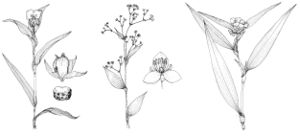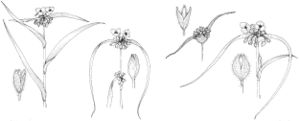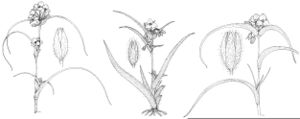Difference between revisions of "Commelinaceae"
FNA>Volume Importer |
FNA>Volume Importer |
||
| Line 113: | Line 113: | ||
|publication year= | |publication year= | ||
|special status= | |special status= | ||
| − | |source xml=https://jpend@bitbucket.org/aafc-mbb/fna-data-curation.git/src/ | + | |source xml=https://jpend@bitbucket.org/aafc-mbb/fna-data-curation.git/src/f6b125a955440c0872999024f038d74684f65921/coarse_grained_fna_xml/V22/V22_297.xml |
}}<!-- | }}<!-- | ||
-->[[Category:Treatment]] | -->[[Category:Treatment]] | ||
Revision as of 19:02, 24 September 2019
Herbs, perennial or annual. Leaves basal or cauline, alternate; sheaths closed; blade simple, often succulent, margins entire, venation parallel. Inflorescences terminal or terminal and axillary [sometimes all axillary], sometimes becoming leaf-opposed, cymose (cymes scorpioid), thyrsiform or variously reduced, sometimes umbel-like, sometimes enclosed in spathaceous bracts. Flowers bisexual or bisexual and staminate on same plants, rarely bisexual and pistillate on same plants [bisexual and unisexual (staminate and pistillate), all on same plants], bilaterally or radially symmetric; sepals 3, sepaloid [occasionally petaloid], distinct or occasionally connate, usually subequal; petals 3, deliquescent, petaloid, distinct or connate, equal or unequal; stamens 6, all fertile or some staminodial or absent (rarely all stamens absent); anthers with longitudinal [rarely poricidal] dehiscence; ovary superior, 2–3-locular; ovules 1-seriate [2-seriate]; style 1, simple, usually slender; stigma 1, simple [rarely slightly 3-lobed], enlarged or not. Fruits loculicidal capsules [rarely indehiscent or berries]. Seeds 1–several [rarely many] per locule; hilum dotlike or linear; lidlike embryotega covering embryo.
Distribution
Pantropical and nearly pantemperate, primarily tropical.
Discussion
The flowers lack nectar and are ephemeral, lasting only a few hours. Their structure is seldom preserved in dried specimens. In the absence of well-pressed flowers, mature buds can be readily dissected in situ, and the arrangement and degree of development of the androecium and gynoecium easily determined.
Some familiar genera, such as Setcreasea, Zebrina, Rhoeo, and Cuthbertia, have been reduced into synonymy under either Tradescantia or Callisia (D. R. Hunt 1975, 1986, 1986b). Further research is needed to corroborate this treatment, especially for the segregate genera of Callisia, such as Cuthbertia. The same generic delimitation has been followed by R. B. Faden (1998), R. B. Faden and D. R. Hunt (1991), and G. C. Tucker (1989).
Genera 40, species ca. 630 (6 genera, 51 species in the flora).
Selected References
Illustrations
Key
| 1 | Inflorescences composed of pairs of contracted, sessile, umbel-like cymes; flowers radially symmetric; stamens 6 (rarely fewer), all fertile. | > 2 |
| 1 | Inflorescences composed of 1–several elongate cymes, not umbel-like; flowers radially or bilaterally symmetric; stamens 6 or fewer, usually some staminodial (rarely all fertile). | > 3 |
| 2 | Cyme pairs enclosed in or subtended by pairs of large, conspicuous spathaceous bracts | Tradescantia |
| 2 | Cyme pairs subtended by small, inconspicuous bracts | Callisia |
| 3 | Inflorescences enclosed in or closely subtended by leafy bracts (spathes); flowers strongly bilaterally symmetric, usually blue (rarely lilac, lavender, peach, apricot, or white). | > 4 |
| 3 | Inflorescences not enclosed in or closely subtended by leafy bracts (although sometimes axillary); flowers radially or bilaterally symmetric, variously colored. | > 5 |
| 4 | Fertile stamens 6, all but proximalmost stamen with filaments densely bearded; capsules 3-valved; leaves glaucous | Tinantia |
| 4 | Fertile stamens 3, filaments glabrous; capsules 2–3-valved; leaves not glaucous | Commelina |
| 5 | Flowers sessile or subsessile; filaments glabrous or bearded; ovary and capsule 2–3-locular | Callisia |
| 5 | Flowers distinctly pedicellate; some or all filaments bearded; ovary and capsule 3-locular. | > 6 |
| 6 | Flowers white to purple or violet; fertile stamens 2–3; staminodes 3–4 | Murdannia |
| 6 | Flowers white; fertile stamens 6; staminodes 0 | Gibasis |


